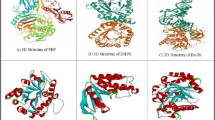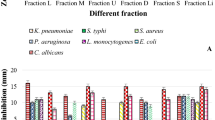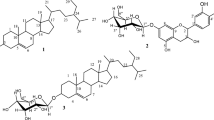Abstract
According to WHO, antibiotic resistance is one of the biggest healthcare challenges to the global community. Therefore, it is absolutely essential to discover new antibiotics to address the challenge. Dicliptera paniculata (ForssK.) I. Darbysh, a rare medicinal herb of Acanthaceae, is known for its noteworthy uses as a flavoring, spicing, and antibacterial agent. The primary goal of the study is to identify novel antibacterials from D. paniculata. The petroleum ether fraction of the methanol extract of D. paniculata was subjected to GC–MS and identified 14 compounds. Several bacterial target proteins were used for molecular docking. The antibacterial activity of petroleum-ether fraction was evaluated on bacteria whose target protein interacts most strongly with identified molecules. The molecules DP_02, DP_06, and DP_14 exhibited the highest docking scores with Staphylococcus aureus dihydrofolate reductase, which were − 6.283, − 7.705, and − 6.364 kcal/mol, respectively. The MM-GBSA binding energy of compounds DP_02, DP_06, and DP_14 were − 46.736, − 42.366, and − 35.734 kcal/mol, respectively. The MM-GBSA binding energy and decent docking score of the compounds DP_02 and DP_06 were both encouraging, and both of the compounds are drug-like. The finding was validated through studies on antibacterial effectiveness against S. aureus and showed encouraging results. These two molecules might serve as the building blocks for the future development of potent antibiotics.





Similar content being viewed by others
References
Adeniyi BA, Odufowora RO (2000) In vitro antimicrobial properties of Aspilia africana (Compositae). Afr J Biom Res 3:167–170
Akbar S, Ishtiaq S, Jahangir M et al (2021) Evaluation of the antioxidant, antimicrobial, and anticancer activities of Dicliptera bupleuroides isolated compounds using in vitro and in silico studies. Molecules 26:7196. https://doi.org/10.3390/molecules26237196
Al-Kharabsheh R, Ahmad M (2022) Skin and mucous membranes colonization with Staphylococcus aureus or MRSA as a risk factor for surgical site infections in elective Caesarean Section. J Obstet Gynaecol 42(5):888–893. https://doi.org/10.1080/01443615.2021.1954147
Bauer AW, Kirby WMM, Sherris JC, Turck M (1966) Antibiotic susceptibility testing by a standardized single disk method. Am J Clin Pathol 45:493–496
Binda C, Newton-Vinson P, Hubalek F, Edmondson DE, Mattevi A (2001) Structure of human monoamine oxidase B, a drug target for the treatment of neurological disorders. Nat Struct Biol 9:22. https://doi.org/10.2210/pdb1GOS/pdb
Clark SB, Hicks MA (2023) Staphylococcal pneumonia. In: StatPearls (Internet). Treasure Island (FL): StatPearls Publishing; 2023 Jan. Available from: https://www.ncbi.nlm.nih.gov/books/NBK559152/
Debnath B, Sharma D, Paul C, Debnath A (2016) New distributional records for the flora of Tripura, India, and their ethnomedicinal uses. Bios Disc 7(2):116–120
Debnath S, Nath M, Sarkar A, Roy G, Chakraborty SK, Debnath B (2022) Phytochemical characterization of Styrax benzoin resin extract, molecular docking, ADME, and antibacterial activity study. Nat Prod Res. https://doi.org/10.1080/14786419.2022.2132244
Ekor M (2014) The growing use of herbal medicines: issues relating to adverse reactions and challenges in monitoring safety. Front Pharmacol 4:177. https://doi.org/10.3389/fphar.2013.00177
Friesner RA, Banks JL, Murphy RB, Halgren TA, Klicic JJ, Mainz DT, Repasky MP, Knoll EH, Shaw DE, Shelley M, Perry JK, Francis P, Shenkin PS (2004) Glide: a new approach for rapid, accurate docking and scoring. 1. Method and assessment of docking accuracy. J Med Chem 47:1739–1749
Friesner RA, Murphy RB, Repasky MP, Frye LL, Greenwood JR, Halgren TA, Sanschagrin PC, Mainz DT (2006) Extra precision glide: docking and scoring incorporating a model of hydrophobic enclosure for protein–ligand complexes. J Med Chem 49:6177–6196
Giwa ZO (2010) Ethnobotany, taxonomy and conservation of medicinal plants Nigeria. Ecology 2010:19–21
Halgren TA, Murphy RB, Friesner RA, Beard HS, Frye LL, Pollard WT, Banks JL (2004) Glide: a new approach for rapid, accurate docking and scoring. 2. Enrichment factors in database screening. J Med Chem 47:1750–1759
Heaslet H, Harris M, Fahnoe K, Sarver R, Putz H, Chang J, Subramanian C, Barreiro G, Miller JR (2009) Structural comparison of chromosomal and exogenous dihydrofolate reductase from staphylococcus aureus in complex with the potent inhibitor trimethoprim. Proteins 76:706
Hevener KE, Zhao W, Ball DM, Babaoglu K, Qi J, White SW, Lee RE (2009) Validation of molecular docking programs for virtual screening against dihydropteroate synthase. J Chem Inf Model 49(2):444–460. https://doi.org/10.1021/ci800293n
Kollman PA, Massova I, Reyes C, Kuhn B, Huo S, Chong L, Lee M, Lee T, Duan Y, Wang W et al (2000) Calculating structures and free energies of complex molecules: combining molecular mechanics and continuum models. Accounts Chem. Res. 33:889–897
Lipinski CA (2016) Rule of five in 2015 and beyond Target and ligand structural limitations, ligand chemistry structure, and drug discovery project decisions. Adv Drug Deliv Rev 101:34–41. https://doi.org/10.1016/j.addr.2016.04.029
Lynch KL (2017) Toxicology: liquid chromatography mass–spectrometry, Hari Nair, William Clarke, mass spectrometry for the clinical laboratory. Academic Press, London, pp 109–130
Mbopi PY, Fozeng HDS, Nguekeu YMM et al (2021) Chemical constituents, total phenolic content, antioxidant activity and bactericidal effect of Dicliptera verticillate (Acanthaceae). S Afr J Bot 142:216–221. https://doi.org/10.1016/j.sajb.2021.07.001
Mehta J, Rolta R, Dev K (2021) Role of medicinal plants from North Western Himalayas as an efflux pump inhibitor against MDR AcrAB-TolC Salmonella enterica serovar typhimurium: in vitro and In silico studies. J Ethnopharmacol. https://doi.org/10.1016/j.jep.2021.114589
Mehta J, Utkarsh K, Fuloria S et al (2022) Antibacterial potential of Bacopa monnieri (L.) Wettst. and its bioactive molecules against uropathogens—an in silico study to identify potential lead molecule(s) for the development of new drugs to treat urinary tract infections. Molecules 27(15):4971. https://doi.org/10.3390/molecules27154971
Prasad R, Melkani AB, Bisht LS et al (2023) The essential oil composition, antimicrobial activity and antioxidant assay of the extracts from aerial parts of Dicliptera roxburghiana Nees. IJNPR 14(4):591–601. https://doi.org/10.56042/ijnpr.v14i4.5889
Renju Krishna V, Drisya V (2018) Preliminary phytochemical, anti-oxidant and antimicrobial studies of D. paniculata, (Forssk.) I. Darbysh. Inter J Dev Res 8(10):23189–23192
Rolta R, Kumar V, Sourirajan A, Upadhyay NK, Dev K (2020) Bioassay guided fractionation of rhizome extract of Rheum emodi wall as bio-availability enhancer of antibiotics against bacterial and fungal pathogens. J Ethnopharmacol 257:112867. https://doi.org/10.1016/j.jep.2020.112867
Salaria D, Rolta R, Patel CN, Dev K, Sourirajan A, Kumar V (2021) In vitro and in silicon analysis of Thymus serpyllum essential oil as bioactivity enhancer of antibacterial and antifungal agents. J Biomol Struct Dyn. https://doi.org/10.1080/07391102.2021.1943530
Sastry GM, Adzhigirey M, Day T, Annabhimoju R, Sherman W (2013) Protein and ligand preparation: parameters, protocols, and influence on virtual screening enrichments. J Comput Aid Mol Des 27(3):221–234
Satyanarayana NV, Lachake SH, Chauhan MG (1993) Pharmacognostical and phytochemical investigation of Peristrophe bicalyculata. Anc Sci Life 12(3–4):420–427
Sawadogo WR, Boly R, Lompo M, Some N, Lamien CE, Guissou IP, Nacoulma OG (2006) Anti-inflammatory, analgesic and antipyretic activities of Dicliptera verticillata. Int J Pharmacol 2(4):435–438
Sharma J, Gaur RD, Painuli RM (2011) Conservation status and diversity of some important plants in the Shiwalik Himalaya of Uttarakhand. India Int J Med Arom Plants 1(2):75–82
Sheeja K, Kuttan G (2007) Activation of cytotoxic T lymphocyte responses and attenuation of tumor growth in vivo by Andrographis paniculata extract and andrographolide. Immunopharmacol Immunotoxicol 29:81–93. https://doi.org/10.1080/08923970701282726
Soutter HH, Miller JR (2009) Wild-type Staphylococcus aureus DHFR in complex with NADPH and trimethoprim. PDB. https://doi.org/10.2210/pdb2W9G/pdb
Tewari D, Sah AN, Pandey HK, Meena HS (2012) A review on phytoconstituents of Ocimum (Tulsi). Int J Ayur Med 3(1):1–9
Wink DA, Vodovotz Y, Grisham MB, DeGraff W, Cook JC, Pacelli R et al (1999) Anti-oxidant effects of nitric oxide. Method Enzymol 301:413–424. https://doi.org/10.1016/S0076-6879(99)01105-2
Acknowledgements
The authors are thankful to the DBT, New Delhi, Govt. of India, for providing funding facility.
Funding
This research work is done under the Project support of the Department of Biotechnology, New Delhi, Govt. of India (Project No. BT/PR16867/NER/95/327/2015 Dated: 13/01/2017).
Author information
Authors and Affiliations
Contributions
AS: Extraction, GC–MS analysis, the study of antibacterial activity, Resource collection, Methodology Validation; SD: Docking, and Editing; BDC: Extraction, Resource collection, Formal analysis; RG: Schrödinger software support; BD: Conceptualization, Writing the original draft, Final editing of the manuscript.
Corresponding author
Ethics declarations
Conflict of interest
The authors declare no conflict of interest.
Additional information
Publisher's Note
Springer Nature remains neutral with regard to jurisdictional claims in published maps and institutional affiliations.
Rights and permissions
Springer Nature or its licensor (e.g. a society or other partner) holds exclusive rights to this article under a publishing agreement with the author(s) or other rightsholder(s); author self-archiving of the accepted manuscript version of this article is solely governed by the terms of such publishing agreement and applicable law.
About this article
Cite this article
Sarkar, A., Debnath, S., Das Chowdhury, B. et al. Identification of phytoconstituents from Dicliptera paniculata and study of antibacterial activity guided by molecular docking. In Silico Pharmacol. 12, 18 (2024). https://doi.org/10.1007/s40203-024-00196-2
Received:
Accepted:
Published:
DOI: https://doi.org/10.1007/s40203-024-00196-2




